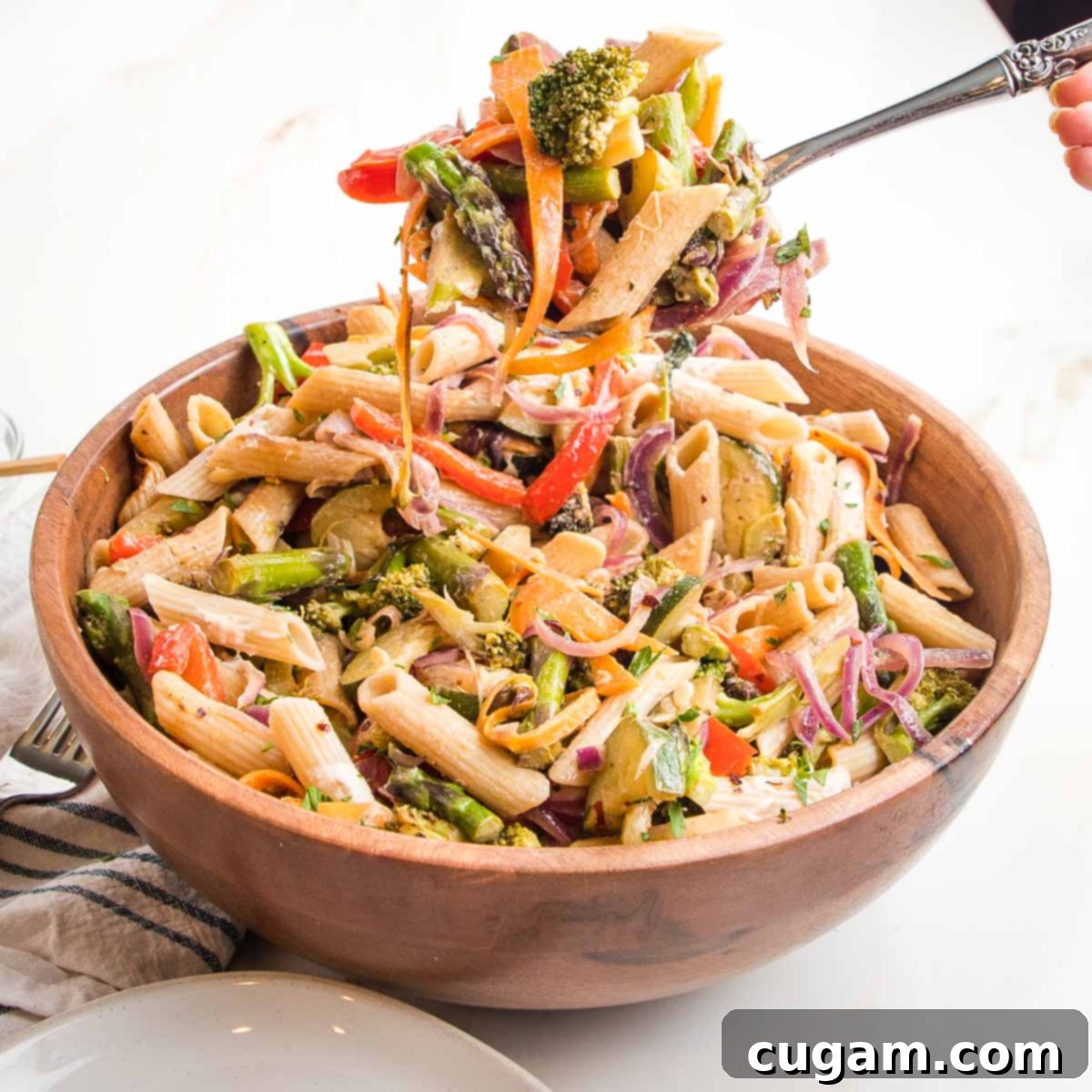Quick & Easy Vegan Pasta Primavera: A Healthy 30-Minute Meal Packed with Fresh Veggies
This delightful Vegan Pasta Primavera Recipe is your ultimate answer for a quick, easy, and incredibly healthy dinner. Imagine a vibrant medley of fresh, seasonal vegetables perfectly sautéed and tossed with your favorite pasta, all coated in a luscious, light lemon tahini sauce. The best part? You can whip up this entire delicious meal in under 30 minutes, making it an ideal choice for busy weeknights or a refreshing weekend lunch. Its burst of colors and flavors will surely make it a cherished, year-round favorite in your healthy eating rotation.
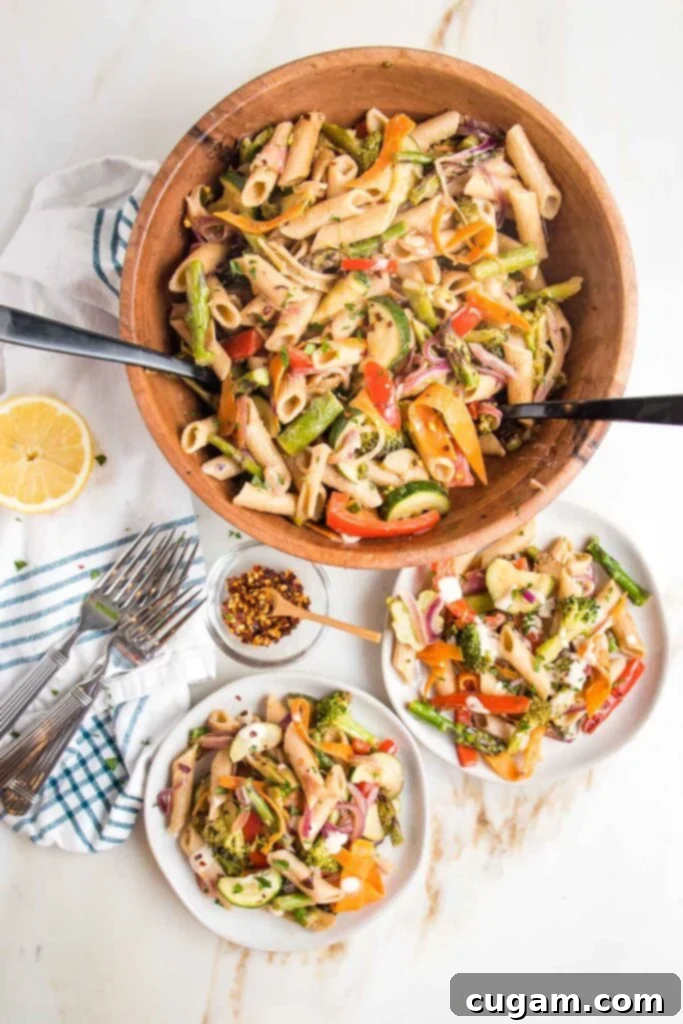
[feast_advanced_jump_to]
While “primavera” traditionally evokes spring, this healthy vegan pasta recipe transcends seasons. It’s a remarkably versatile and utterly delicious way to incorporate an abundance of fresh vegetables into your diet, no matter the time of year. Whether it’s the crisp bounty of spring, the sunny harvest of summer, or even the hearty greens of fall and winter, this dish adapts beautifully to whatever fresh produce is available.
Traditional pasta primavera often features a rich lemon cream sauce. Our innovative, dairy-free version offers a wonderfully light and zesty alternative. It harnesses the subtle tang of white wine and the creamy richness of tahini to create a perfect vegan primavera sauce that the entire family will absolutely adore. This plant-based twist delivers all the comfort and flavor you crave, without any dairy.
If you’re on the hunt for an easy, healthy, and plant-based dinner that tastes truly incredible and can be on your table in less than half an hour, your search ends here. This Vegan Pasta Primavera is simple, satisfying, and sensationally flavorful.
Why You’ll Absolutely Love This Vegan Pasta Primavera
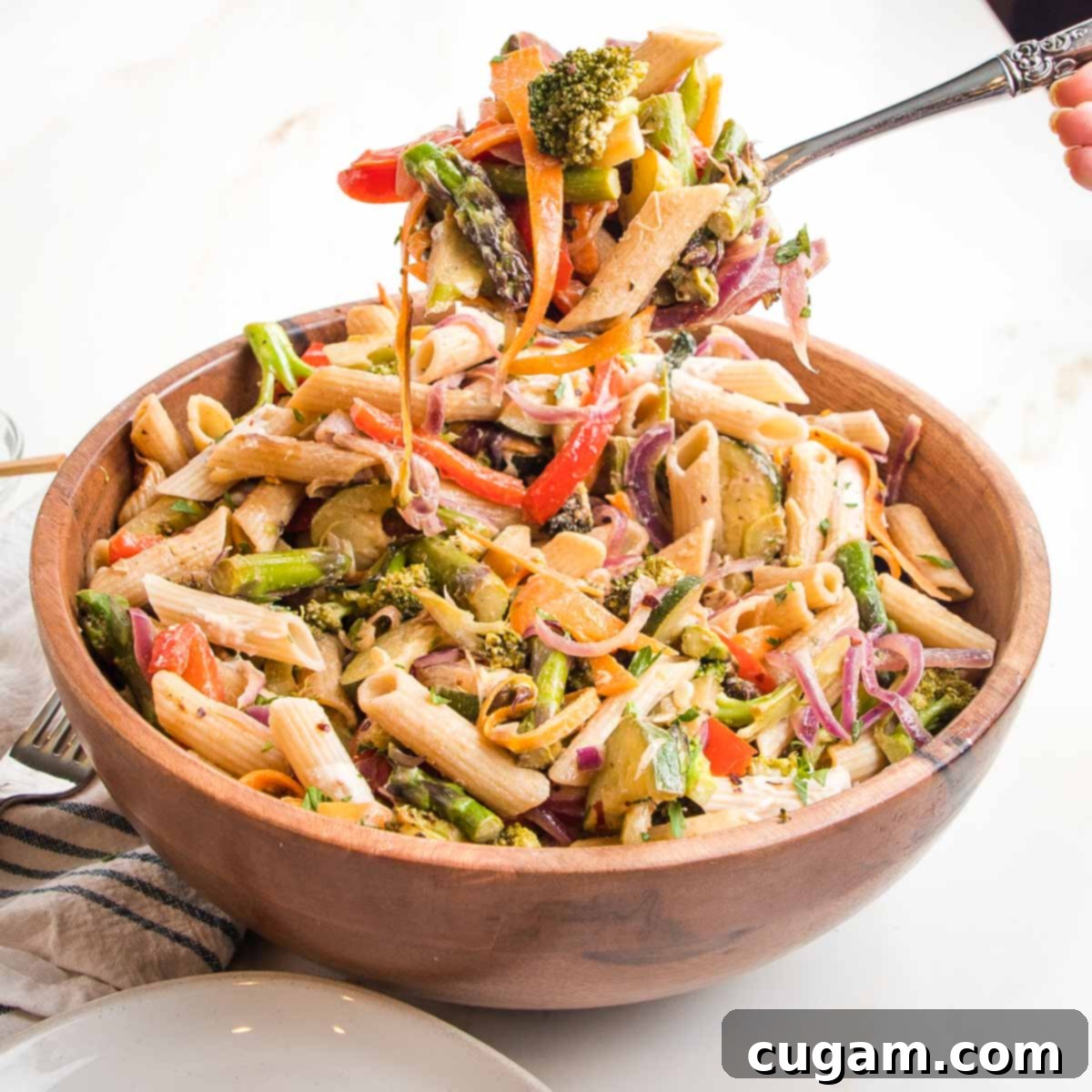
- Light, Yet Incredibly Filling: You’ll be amazed at how satisfying this dish is, despite its light and zesty dairy-free lemon tahini sauce. It strikes the perfect balance between fresh and hearty, leaving you feeling comfortably full without being weighed down.
- Nutrient-Dense Powerhouse: This is a super tasty and effortless way to boost your daily vegetable intake. Packed with a colorful array of fresh produce, each bite delivers a wealth of vitamins, minerals, and fiber, contributing significantly to your overall well-being.
- Ultimate Vegan Comfort Food: Experience the delightful satisfaction of classic comfort food with a healthy, plant-based twist. The tender pasta, combined with a generous portion of vibrant veggies and our delectable vegan sauce, creates a truly fulfilling meal. If you’re a fan of healthy vegan pasta dishes, be sure to also try this vegan pesto pasta or my delicious sesame noodles with veggies.
- Crowd-Pleasing Plant-Based Meal: This recipe is so incredibly good that it will win over even the most devoted omnivores. It’s an excellent way to introduce more plant-based meals to your friends and family, proving that healthy eating can be utterly delicious and universally appealing.
- Bursting with Flavor in Every Bite: From the bright citrus notes of lemon to the earthy depth of tahini and the freshness of herbs, every forkful is a symphony of flavors that will tantalize your taste buds. The crushed red pepper adds an optional, delightful zing.
- Gorgeous and Visually Appealing: We truly eat with our eyes first! The vibrant colors of the freshly sautéed vegetables—red bell pepper, green broccoli, orange carrots, and purple onion—make this dish an absolute feast for the eyes, as beautiful as it is delicious.
Crafting the Perfect Lemon Tahini Primavera Sauce: Key Ingredients
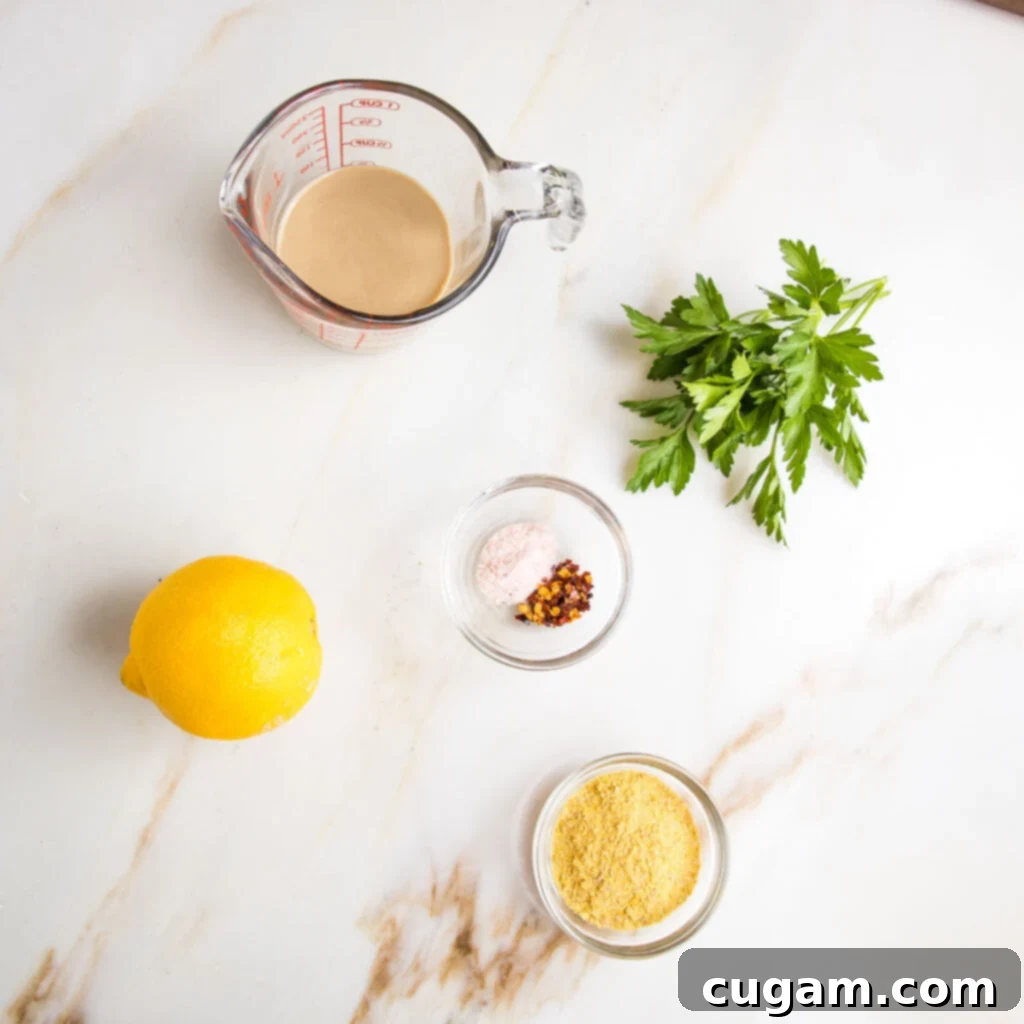
- Tahini: This incredible ingredient forms the creamy, dairy-free base of our sauce without the need for added oils. Tahini, made from ground sesame seeds, is a whole food ingredient rich in antioxidants and essential minerals like calcium. It’s also known for its anti-inflammatory properties, making it a healthy and flavorful choice for creating velvety sauces and dressings.
- Lemon: To achieve that signature bright and refreshing primavera flavor, we harness both the zest and the juice of fresh lemons. The zest provides an intense aromatic citrus punch, while the fresh lemon juice keeps the sauce wonderfully light and tangy, perfectly complementing the rich tahini.
- Salt & Pepper (S+P): These essential seasonings elevate all the other flavors. If you’re mindful of sodium intake, feel free to reduce or omit the salt, opting for a no-salt seasoning blend instead. Always start with a smaller amount of salt and adjust to taste at the end. For a delightful kick, I love adding crushed red pepper flakes; however, you can easily substitute with freshly cracked black pepper if you prefer a milder spice.
- Nutritional Yeast: This is our secret weapon for a savory, “cheesy” vegan flavor. I typically sprinkle nutritional yeast on top of the finished dish as a garnish, but you can also whisk some directly into the sauce mixture to infuse a deeper umami note throughout.
- Fresh Herbs: Fresh herbs are non-negotiable for that vibrant, aromatic finish. Parsley is my go-to for its bright, clean taste in this dish. However, feel free to experiment with other finely chopped fresh herbs like basil, oregano, or thyme to add your personal touch and enhance the overall freshness.
How to Make Your Delicious Vegan Pasta Primavera
Successful and speedy pasta primavera relies on good preparation. Before you even think about heating a pan, ensure all your vegetables are prepped and ready. Since they will only require a quick sauté to achieve that perfect al dente texture, precise and uniform cutting beforehand is crucial for even cooking.
Expert Tips for Cutting Fresh Veggies
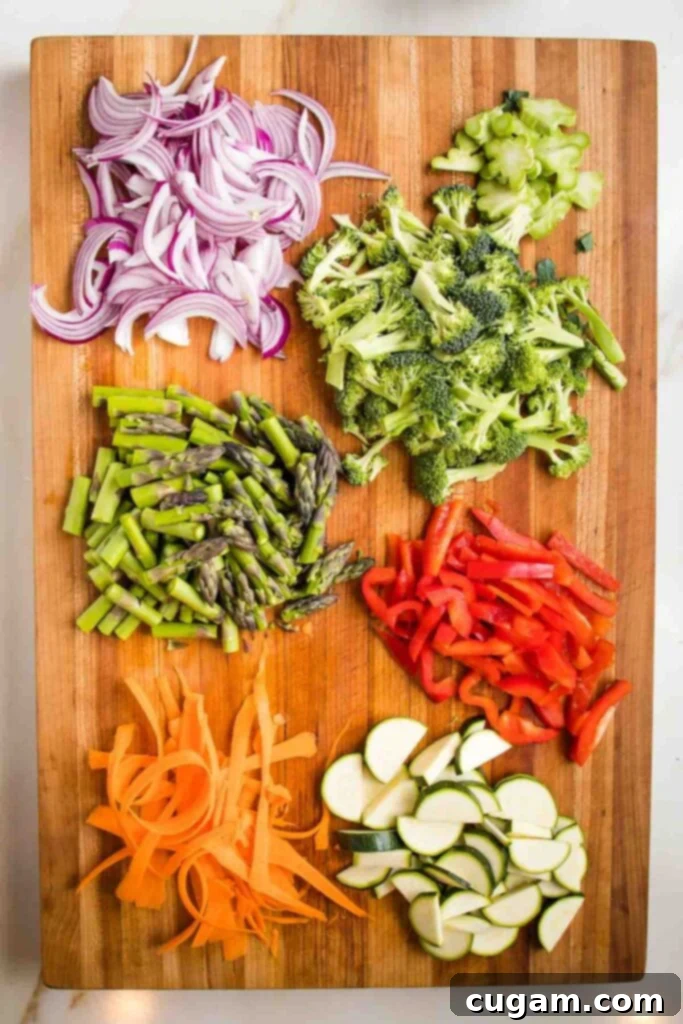
Always prioritize buying fresh vegetables that are in season for the best flavor and nutritional value. You can find an incredible array of spring or summer vegetables at local farmers’ markets or your local grocery store. A key tip for even cooking is to cut all your veggies into similar sizes; this ensures they become tender at the same time. Pay close attention to the thickness of your cuts, as it directly impacts cooking duration.
For this recipe, you’ll want a minimum of 5 cups of fresh, finely chopped vegetables to create a truly satisfying and nutrient-packed primavera.
- Red Onion: Begin by cutting the onion in half, then peel off any papery outer layers. For stability and even slicing, place the onion cut-side down on your cutting board, then slice it into thin, crescent-shaped strips.
- Asparagus Spears: First, snap or cut off the tough, woody ends of the asparagus. These tend to be fibrous and unpalatable. Then, trim the tender spears into roughly 1-inch pieces.
- Carrots: Peel your carrots and trim off both ends. For quick cooking and elegant presentation, use a vegetable peeler to create long, thin ribbons. If you prefer, you can cut them into ¼-inch discs, but remember that thicker cuts will require a bit longer to cook through.
- Fresh Broccoli: Don’t discard the stalk! If the broccoli stalks are substantial, slice them into thin discs and add these to the pan early in the cooking process. Use a sharp knife to cut the green crowns into florets of similar, bite-sized proportions for even cooking.
- Red Bell Pepper: While I prefer red for its sweetness and color, you can use any color bell pepper you have on hand, or even a mix for extra visual appeal. Start by slicing a thin sliver off the top and bottom, then cut the sides into uniform strips.
- Zucchini or Yellow Squash: When selecting summer squash, look for varieties that are long and thin, as the rounder ones often contain more seeds and can be slightly more bitter. Trim a thin slice off both ends, then slice the squash in half lengthwise. Finally, proceed to cut it into ¼-inch half-moons.
Once all your vibrant vegetables are prepped and neatly set aside, it’s time to get the pasta cooking. Bring a large pot of generously salted water to a rolling boil. Pour in your chosen pasta and cook it according to the package instructions, but with one critical adjustment: set your timer for 2 minutes LESS than the recommended cooking time. This is especially vital when using gluten-free pasta, which can quickly become mushy if overcooked. Our goal is perfectly al dente pasta – firm to the bite, ensuring it doesn’t get gummy or stick together when mixed with the sauce and veggies.
Choosing the Best Pasta for Your Primavera
For this recipe, I often use Jovial Gluten-free Brown Rice Penne, which holds its shape beautifully and offers a satisfying texture. However, the beauty of pasta primavera lies in its adaptability! Sometimes I opt for linguine, which coats wonderfully, or even broad pad thai noodles for a different twist. Fusilli is another excellent choice, as its corkscrew shape provides plenty of crevices for the delicious sauce to cling to, ensuring maximum flavor in every bite. Yum!
Ultimately, you can use whatever pasta shape you prefer and a variety that suits your dietary needs. Just remember our golden rule: aim for al dente pasta. Start testing for doneness approximately 2 minutes before the package directions suggest to achieve that perfect firm-to-the-bite consistency.
How to Create the Irresistible Vegan Primavera Sauce
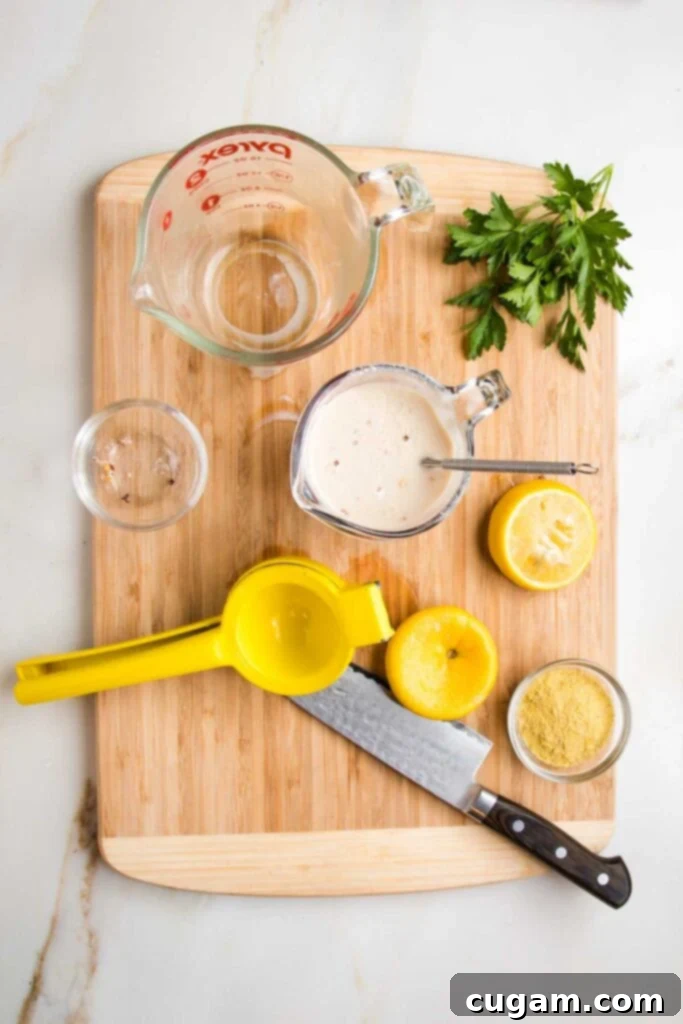
- Begin by vigorously whisking together the creamy tahini with freshly squeezed lemon juice, coarse sea salt, and a dash of crushed red pepper flakes. Whisk until the mixture is well combined and slightly thickened.
- Next, carefully scoop out about a cup of the starchy pasta cooking water using a Pyrex glass measuring cup. Slowly whisk in about ½ cup of this pasta water into your tahini mixture. Continue whisking until the sauce thins out to a pourable, creamy consistency. If it’s still too thick, add more pasta water, one tablespoon at a time, until you reach your desired texture. Make sure to save any remaining pasta water; you might need it later to adjust the sauce’s consistency or to deglaze the pan.
- Finally, whisk in half of the nutritional yeast directly into the sauce. This will infuse a subtle savory, cheesy flavor throughout. Reserve the remaining nutritional yeast to sprinkle on top as a garnish, along with your freshly chopped parsley, for a final flourish.
Now, it’s time to bring those vibrant vegetables to life! Heat a large skillet, preferably cast iron, over medium-high heat. Swirl in about 1 tablespoon of olive oil, vegetable broth, or even a splash of the reserved pasta water to start your veggie sauté. The key is to add your fresh vegetables one at a time, beginning with those that require the longest cooking time to become tender, and allowing each a minute or so to cook before adding the next.
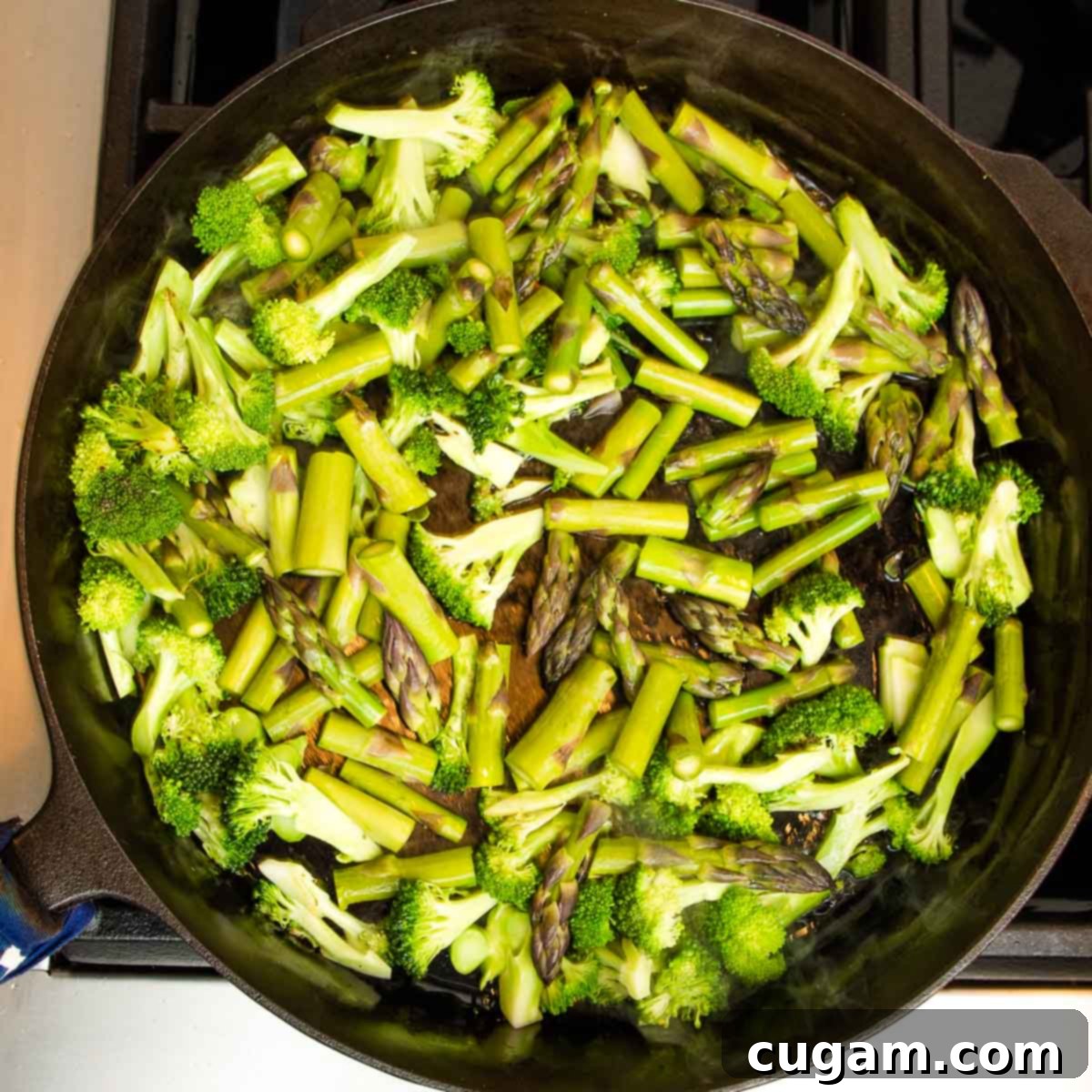
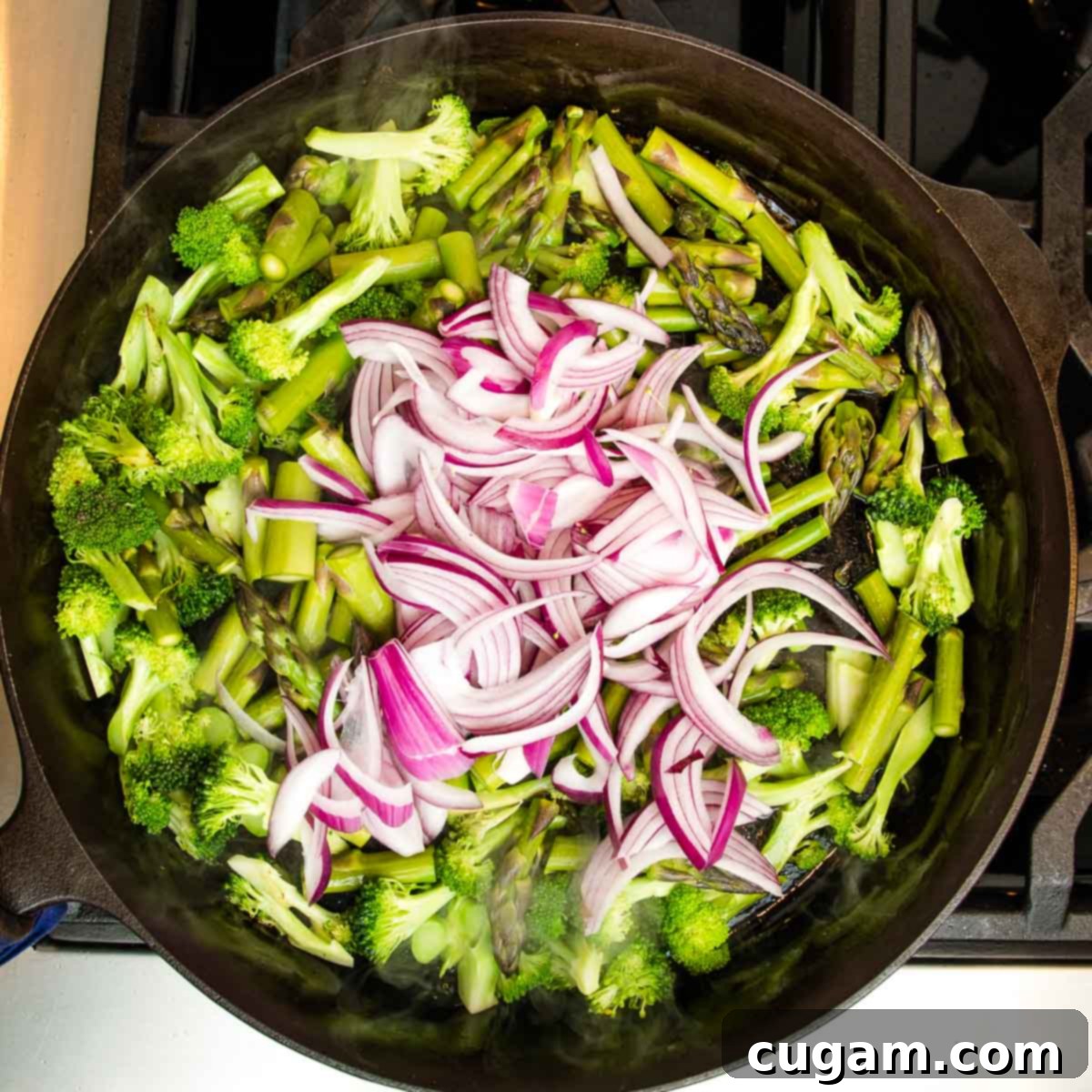
Following this thoughtful sequence, start by adding the broccoli stalk spheres, followed by any thicker asparagus pieces. Allow these to cook for about a minute to soften slightly, then stir in the broccoli florets. Let them cook for another minute before adding the thinly sliced red onions. As you sauté, keep an eye on the pan. If it starts to look dry, don’t hesitate to add 1-2 tablespoons of white wine, vegetable stock, or more pasta water to deglaze the pan and prevent sticking, ensuring your veggies cook beautifully.
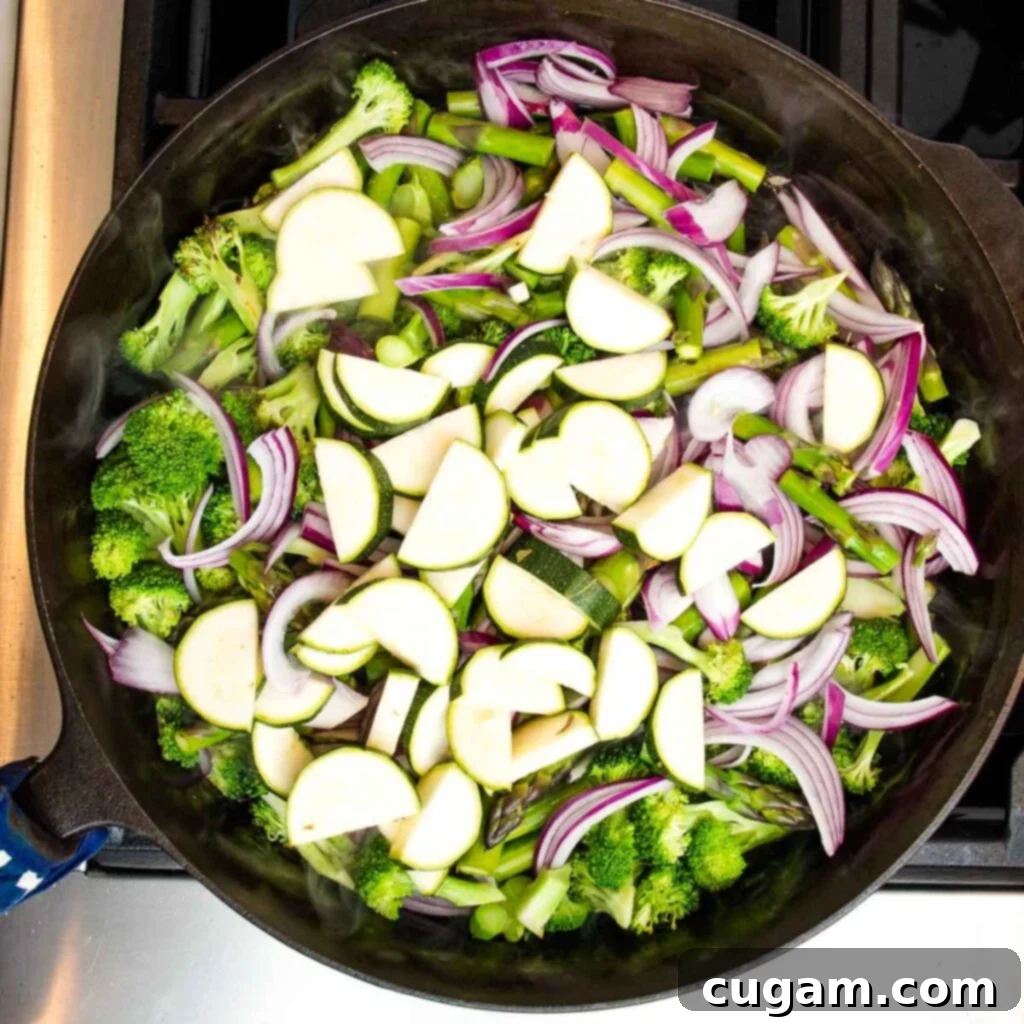
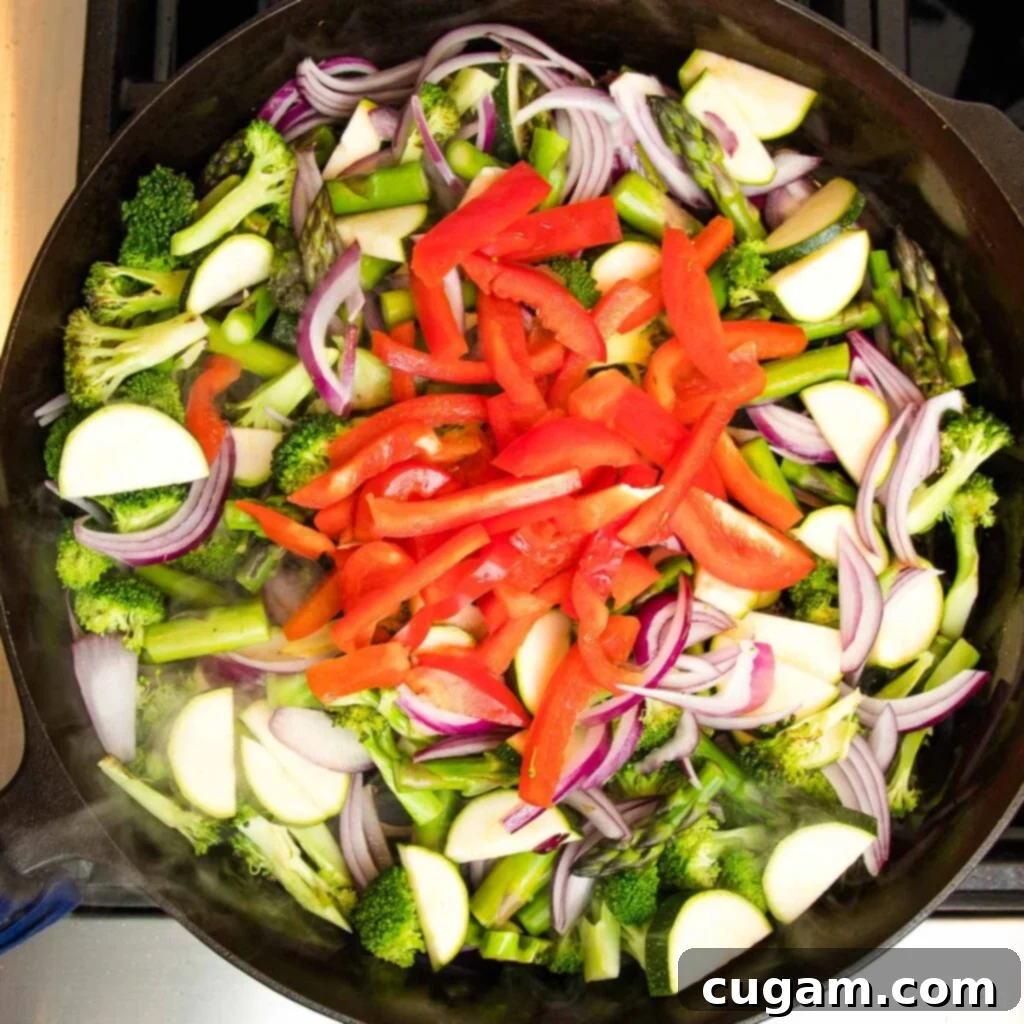
Continue building your veggie medley by adding the zucchini half-moons and the red bell pepper strips. Toss everything thoroughly to combine and ensure even cooking. Again, if the pan appears dry, add another tablespoon of liquid – white wine, vegetable broth, or pasta water – as needed. While the alcohol in white wine will burn off, leaving behind a delightful depth of flavor, if you prefer to avoid alcohol entirely, simply replace the wine with additional vegetable broth for equally delicious results.
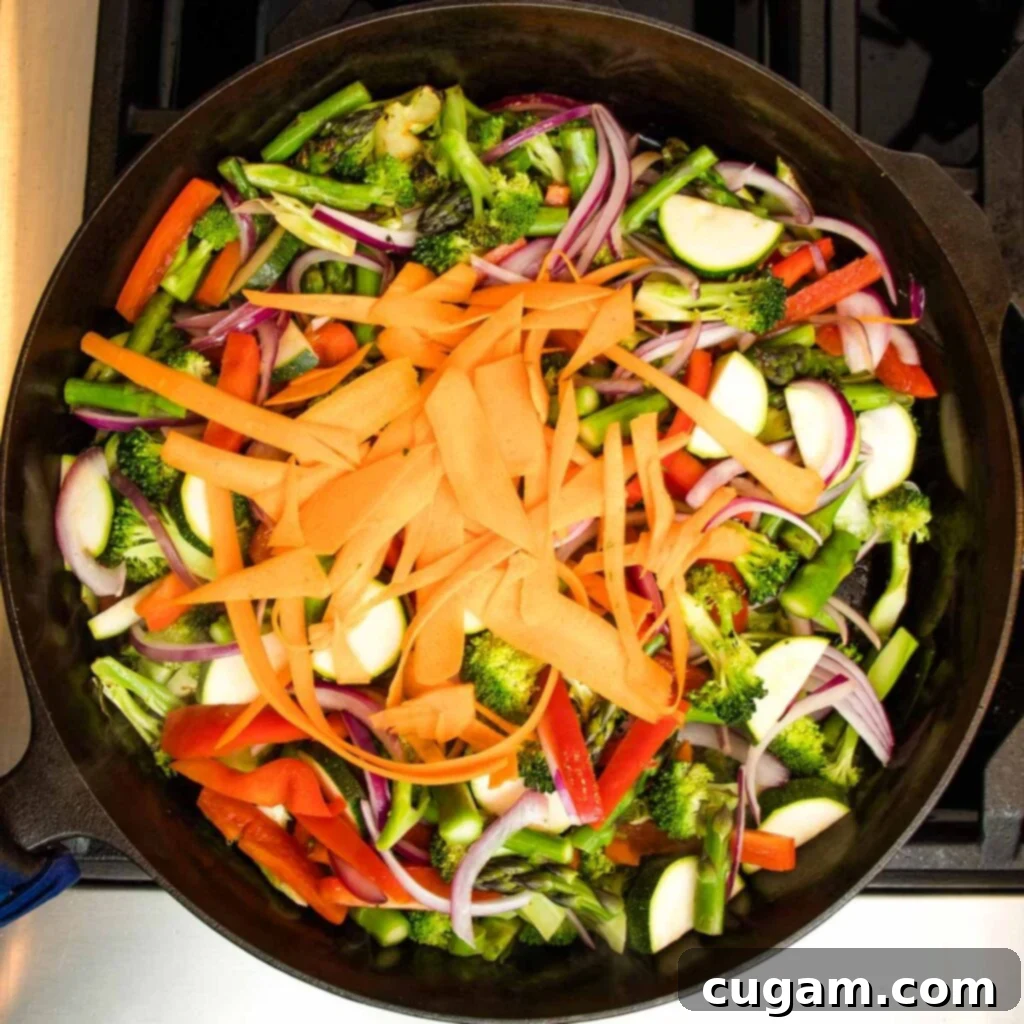
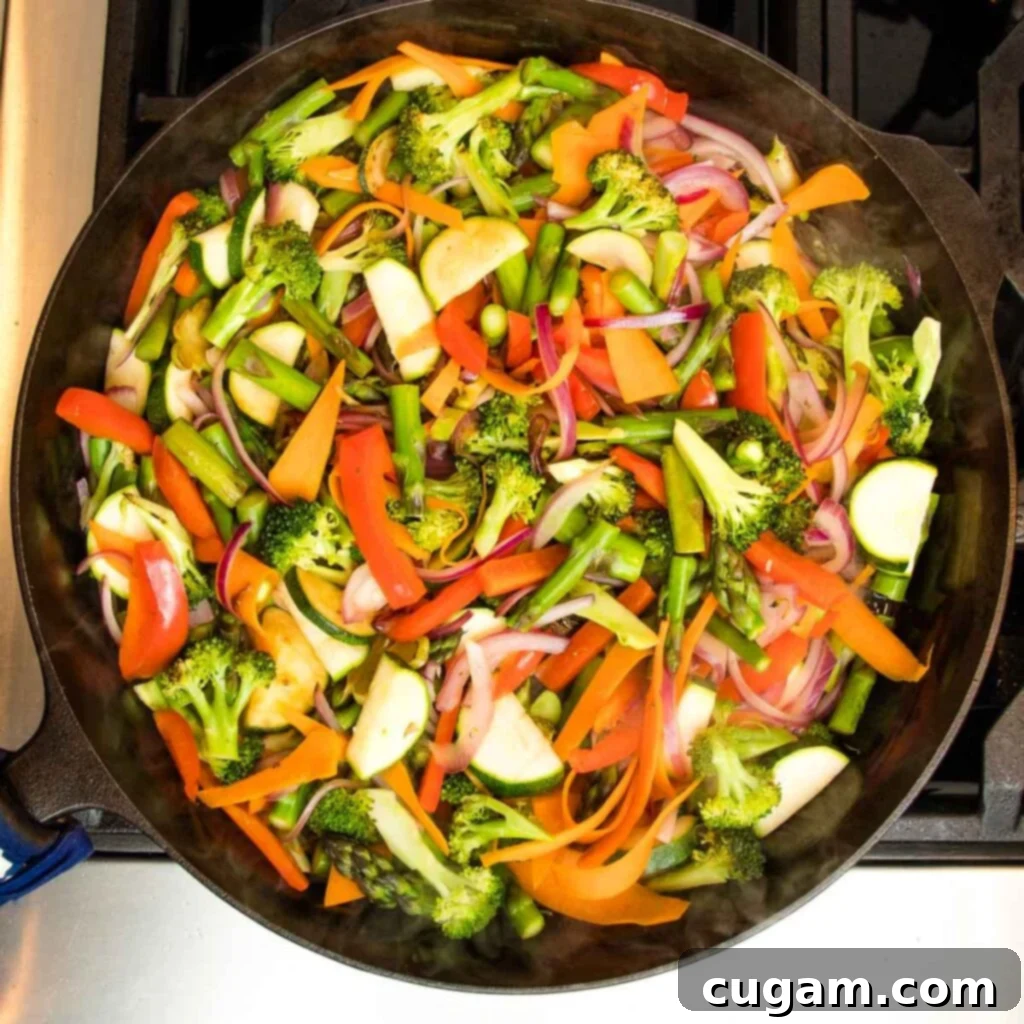
The final vegetable to incorporate into your vibrant mixture is the delicate carrot ribbons. Add them to the pan along with 1 teaspoon of dried Italian seasoning. Toss gently to combine, allowing the flavors to meld and the carrots to soften just slightly, retaining their crispness.
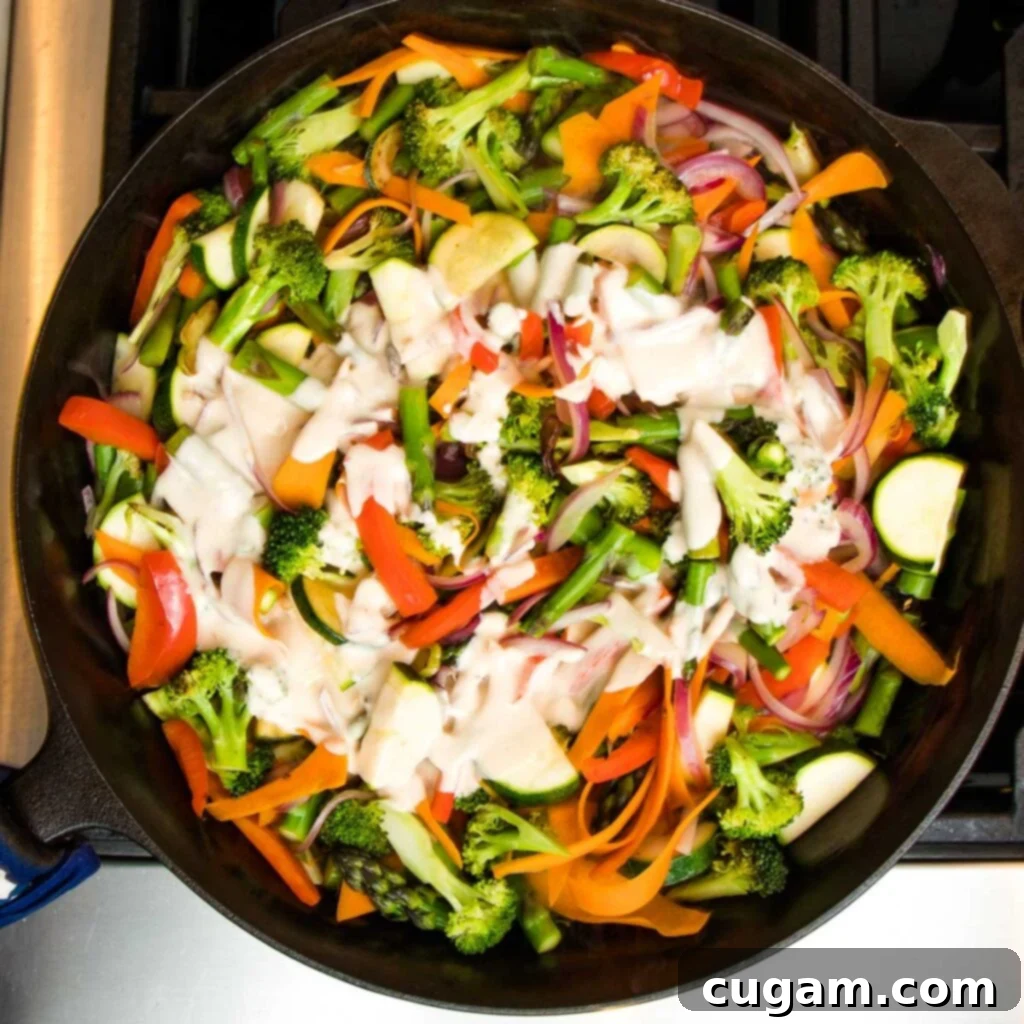
Once your vegetables are beautifully bright in color and perfectly tender-crisp (never mushy!), it’s time for the crowning glory. Pour about half of your prepared lemon tahini sauce over the sautéed veggies and stir it in thoroughly, ensuring every piece is coated in its creamy goodness. The aroma will be absolutely divine!
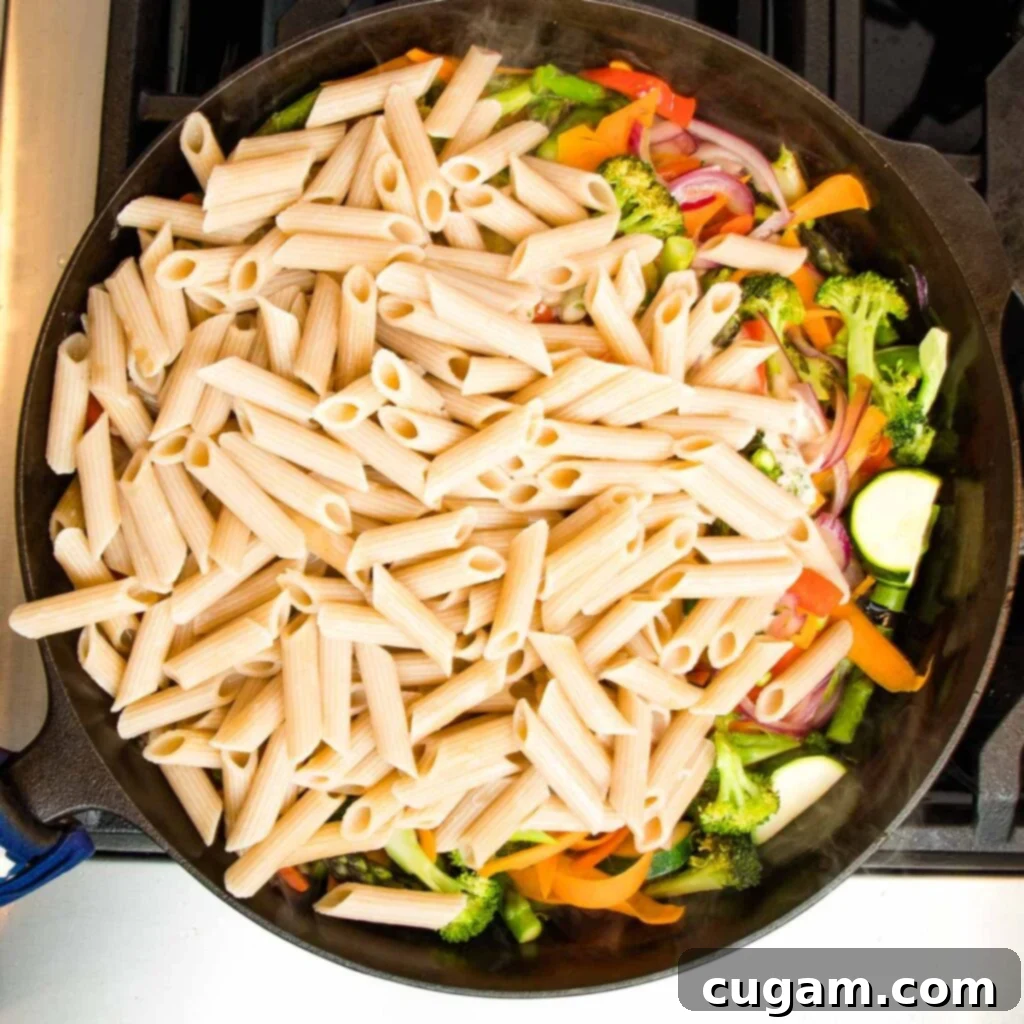
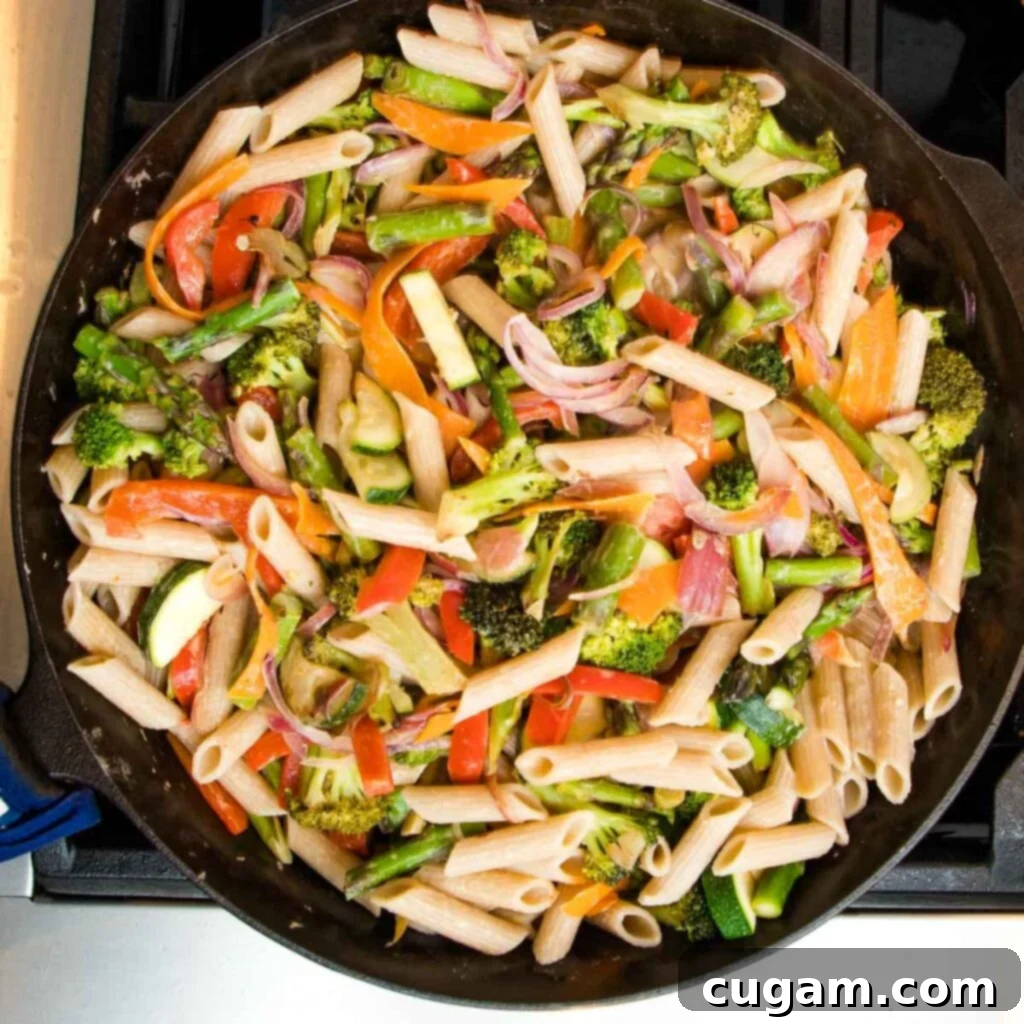
If your skillet is generously sized, you can directly add the drained, al dente pasta into the pan with the vegetable and sauce mixture and toss everything together until evenly distributed. Alternatively, for easier mixing or if your skillet is smaller, simply transfer the cooked vegetable mixture into the large pot you used for the pasta. This ensures plenty of room to gently fold the flavorful veggies and sauce into the tender pasta without making a mess.
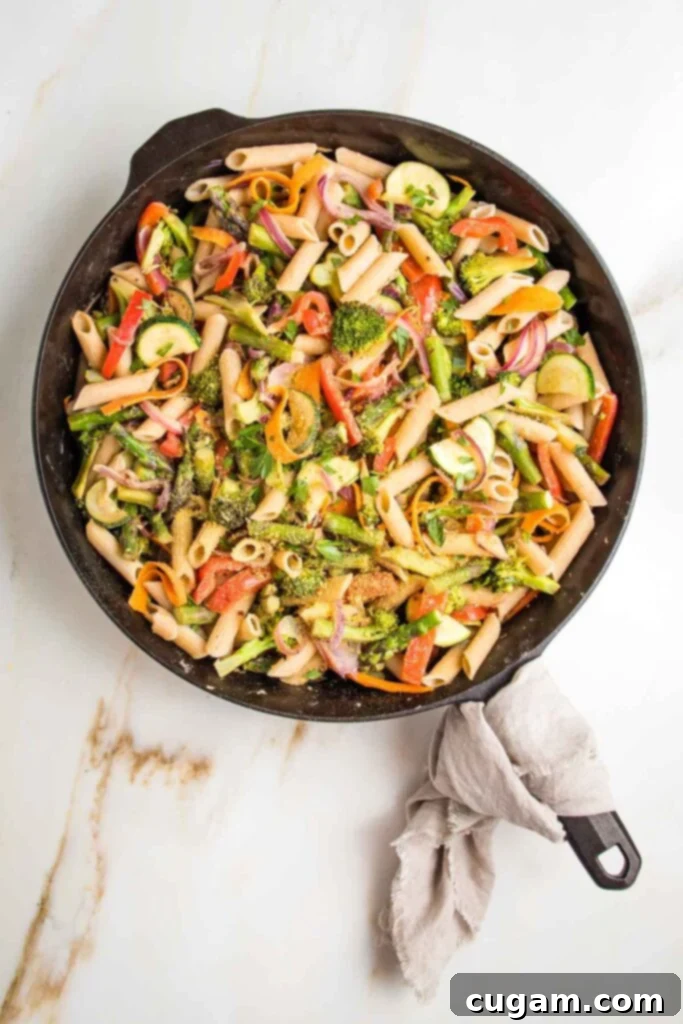
Before serving, sprinkle on any additional nutritional yeast you reserved, a generous amount of fresh chopped herbs (like parsley or basil), and a final squeeze of fresh lemon juice if you desire an extra zing. Serve your Vegan Pasta Primavera warm, inviting everyone to customize their plate with extra crushed red pepper flakes for a touch of heat. This dish is a celebration of freshness, flavor, and effortless plant-based cooking.
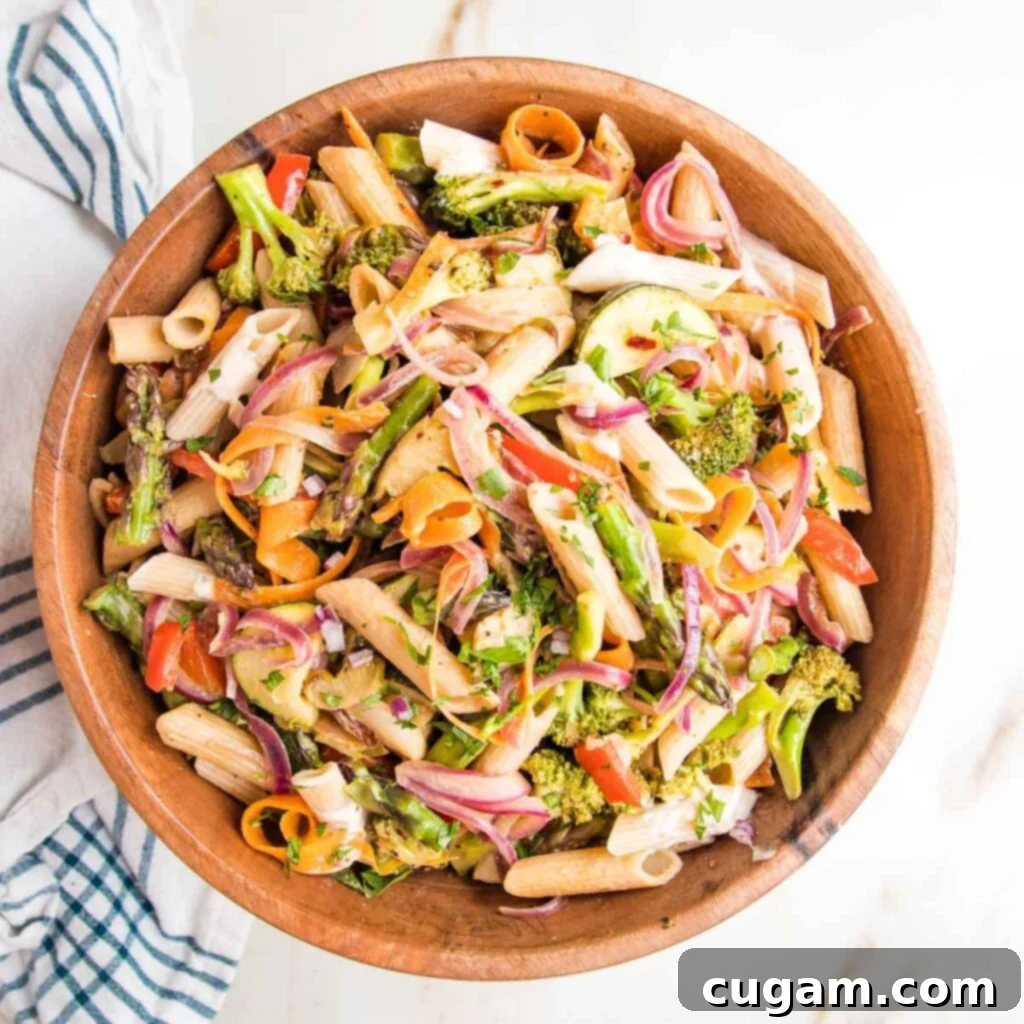
Maximizing Flavor: Meal Prep and Storage Tips
- Serving Suggestions: This vibrant recipe is designed to serve 4 as a hearty vegan main dish. If you’re looking to stretch it further or serve it as a lighter side dish, consider adding even more fresh veggies or incorporating a can of small white beans for added protein and bulk. While this pasta primavera tastes best served warm, its fresh flavors also make it an excellent cold pasta salad, perfect for picnics or packed lunches.
- Prep Ahead for Convenience: To make mealtime even quicker, you can easily prep components in advance. Cut all your vegetables and store them in separate airtight containers in the refrigerator for up to 2-3 days until you’re ready to cook. The lemon tahini primavera sauce can also be prepared up to 3 days ahead of time (when making the sauce in advance, use veggie broth instead of pasta water for thinning). Store the sauce in a lidded glass jar in the fridge. Before adding it to your tender veggies, a bit of pasta water can be whisked in to warm it up and perfect its consistency.
- Storing Leftovers: Any leftover pasta primavera can be stored in an airtight container in the refrigerator for up to 5 days. For reheating, gently warm the dish on the stove in a heavy skillet over medium-low heat. To prevent it from drying out, add a splash of white wine, a little lemon juice, or some vegetable broth while reheating, which will also refresh the flavors.
- Freezing: Unfortunately, this delightful dish doesn’t freeze particularly well. The fresh vegetables and the creamy sauce tend to lose their optimal texture and consistency upon thawing. It’s truly best enjoyed freshly made or as refrigerated leftovers.
Debra’s Pro Tips for the Best Vegan Pasta Primavera
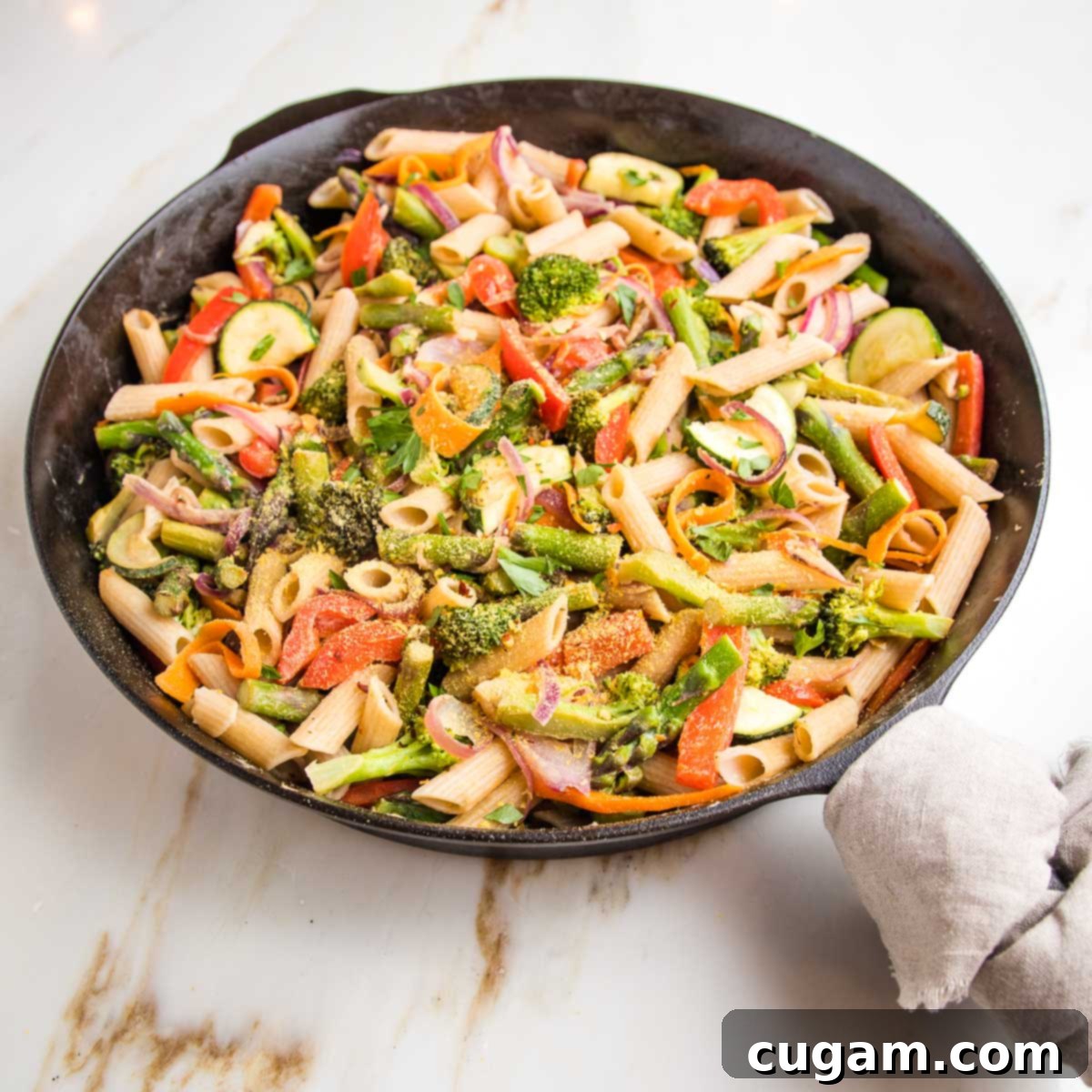
- Serve Warm or Cold: This recipe is incredibly versatile! Enjoy it warm straight from the stove for a comforting meal, or chill it and serve it cold as a refreshing pasta salad, perfect for summer gatherings, potlucks, or packed lunches.
- Does Gluten-Free Pasta Primavera Taste Good? Absolutely! Yes, opting for gluten-free pasta in this recipe works wonderfully. The trick, however, is to be vigilant to prevent it from becoming mushy. Always aim for an al dente texture. As a guideline, set your timer for 2 minutes LESS than the package directions suggest, and start testing for doneness early.
- Strategic Vegetable Sautéing: Always add your vegetables to the pan in the order of their cooking time. Thicker, denser vegetables like broccoli stalks will require more time and should go in first, while thinner, quicker-cooking items should be added later. For instance, if your asparagus spears are particularly thick, add them early. Super thin asparagus or delicate carrot ribbons, on the other hand, can be added at the very end to ensure they remain tender-crisp and maintain their vibrant color. Conversely, ¼-inch carrot rounds will take longer than ribbons and should be added closer to the beginning of the sauté.
- Embrace Variety with 5+ Cups of Veggies: The specified 5 cups of assorted vegetables give you plenty of creative wiggle room to use whatever fresh produce you have on hand or what looks best at the market. Don’t be afraid to experiment with different combinations to find your favorite medley!
- Easily Stretch the Recipe: If you need to feed a larger crowd or simply want more leftovers, this recipe is easily doubled. Just make sure to proportionally increase both the amount of pasta and, crucially, the creamy lemon tahini sauce and the total volume of vegetables.
- Extra Sauce for Extra Flavor: Don’t underestimate the power of extra sauce! Prepare a little more sauce than the recipe calls for, and pass it around the table for those who prefer an extra creamy coating. Any additional sauce can be stored in the fridge and used when reheating your pasta primavera on the stove, helping to refresh its flavor and texture.
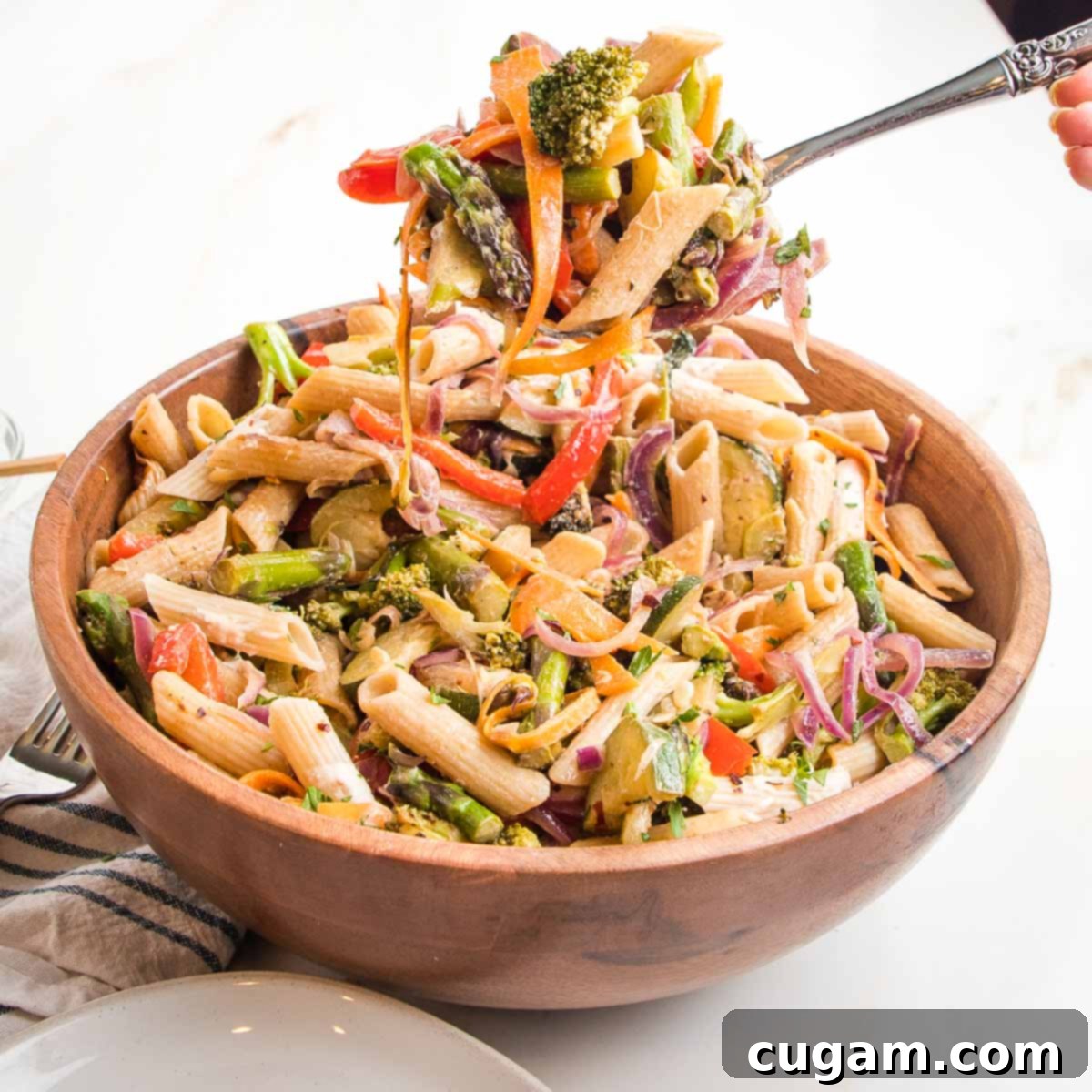
Explore More Delicious Vegan Italian Main Dish Recipes:
- Vegan Zucchini Rollatini (gluten-free)
- Vegan Stuffed Peppers with Lentils
- Meaty Vegan Stuffed Zucchini Boats
- Gluten-free and Vegan Vegetable Lasagna
Did you know commenting and rating recipes is one of the best ways to support your favorite food bloggers? If you made this recipe, please consider a five-star rating below and leave a comment sharing your experience. Also, we’d love to see your culinary creations! Please share your photos on Instagram by tagging me @dkhealthcoach and using the hashtag #debraklein. Your support means the world!
📖 Recipe
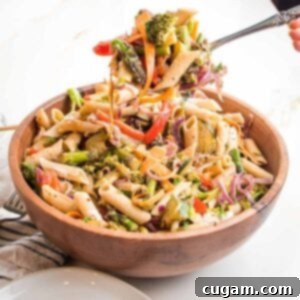
Vegan Pasta Primavera
Debra Klein
Rate this Recipe
Pin Recipe
10
minutes
15
minutes
25
minutes
Main Course
Italian
4
servings
349
kcal
Equipment
-
Mini whisks
-
Cast iron skillet
-
Citrus Squeezers
-
Pyrex Glass Measuring Cup Set
Ingredients
-
1
lb.
gluten-free pasta* -
1
Tablespoon
olive oil -
1
medium red onion
sliced thin -
1
red bell pepper
cut into thin strips -
2
broccoli crowns
cut into florets -
1
medium zucchini
cut into half moons -
1
large carrot
peeled into long, thin strips -
1
bunch asparagus
cut into 1″ pieces -
1
teaspoon
dried Italian seasoning -
2-3
Tablespoons
white wine
Pasta Primavera Sauce
-
¼
cup
tahini -
1
lemon
juiced -
½
teaspoon
coarse sea salt -
¼
teaspoon
crushed red pepper -
½
cup
pasta water
Garnish
-
¼
cup
chopped parsley -
1
Tablespoon
nutritional yeast
Instructions
-
PREP THE VEGGIES: Meticulously prepare your vegetables for optimal cooking. Cut the red onion in half, then slice it into thin strips. Stem and seed the red bell pepper, then chop it into thin, uniform strips. Thinly slice the stalk of fresh broccoli and then separate the top into bite-sized florets. Trim both ends off the zucchini, slice it in half lengthwise, and then proceed to cut it into ½-inch half-moons. Trim and peel your carrot, then use a vegetable peeler to create long, thin strips or ribbons. Finally, cut your asparagus into 1-inch pieces, ensuring all woody ends are removed.
-
Bring a large pot of generously salted water to a rolling boil. Add your chosen pasta and cook according to the package directions. It is crucial not to overcook the pasta for this dish; this easy pasta primavera tastes best when the pasta is cooked perfectly al dente, meaning it’s firm to the bite. Generally, this will translate to 2 minutes LESS cooking time than what the package instructions recommend. Stir the pasta once or twice during cooking to prevent it from clumping together.
-
MAKE THE PRIMAVERA SAUCE: In a medium bowl, vigorously whisk together the tahini, fresh lemon juice, coarse sea salt, and crushed red pepper flakes until well combined. Use a Pyrex glass measuring cup to scoop out 1 cup of the hot pasta water. Gradually pour ½ cup of this starchy water into the creamy tahini mixture, whisking continuously until the sauce is smooth and creamy. If the sauce appears too thick, add a bit more pasta water, one tablespoon at a time, until you achieve a pourable, desired consistency. Set the finished sauce aside.
-
Heat a large, heavy skillet (preferably cast iron) over medium-high heat. Swirl in just one tablespoon of olive oil or a splash of pasta water. Begin adding your fresh vegetables to the pan, cooking them in stages: start with the broccoli stalk pieces, then the asparagus, followed by the red onion, then zucchini, red pepper, and finally the carrot ribbons. Toss with large tongs in between each addition, allowing each type of vegetable to cook for about a minute to retain its crispness. If the pan becomes too dry during this sautéing process, add 1-2 tablespoons of white wine or vegetable broth to deglaze and keep the vegetables from sticking. Sprinkle on the Italian seasoning towards the end and continue to toss and cook until all the veggies are brightly colored and still tender-crisp, not mushy.
-
Once the vegetables are perfectly cooked, pour about half of the prepared lemon tahini sauce over them and stir well, ensuring everything is thoroughly coated. If your pan is sufficiently large, add the cooked and drained pasta directly into the skillet with the vegetables and sauce, mixing well to combine. Alternatively, if your pan is smaller, drain the pasta and return it to the pot it was cooked in, then pour the entire vegetable and sauce mixture over the tender pasta. Mix thoroughly until the pasta is evenly coated with the vibrant veggies and creamy sauce. To finish, sprinkle with the reserved nutritional yeast, fresh chopped parsley, and taste for any final seasoning adjustments. You can also add some sliced green onions or an extra squeeze of fresh lemon juice to taste for a final burst of freshness. Serve immediately and enjoy!
Notes
PASTA: Any type of pasta will work beautifully in this recipe, allowing for great flexibility. I personally used Jovial Rice Pasta and cooked it for approximately 10 minutes, achieving a perfect texture. The golden trick with gluten-free pasta, to ensure it doesn’t turn mushy, is to always cook it al dente. Use the package directions as a helpful guideline, but remember to set your timer for 2 minutes LESS than the suggested cooking time, and test early for that ideal firm-to-the-bite consistency.
VEGGIES: The truly wonderful aspect of this easy vegan pasta primavera recipe is its incredible adaptability to various fresh vegetables, allowing you to tailor it to the season. While I featured fresh spring vegetables in these accompanying photos, you are highly encouraged to use whatever seasonal vegetables are readily available at your local grocery store or farmers’ market. Other fantastic additions that would complement this classic Italian dish beautifully include crisp green beans, sweet green peas, delicate snow peas, vibrant snap peas, tender yellow squash, juicy cherry tomatoes, fragrant fresh basil, or any other fresh herbs you have on hand to enhance its flavor profile.
Nutrition
Serving:
1
g
Calories:
349
kcal
Carbohydrates:
41
g
Protein:
10
g
Fat:
13
g
Saturated Fat:
2
g
Polyunsaturated Fat:
10
g
Sodium:
296
mg
Fiber:
10
g
Sugar:
5
g
Note
The nutrition calculations were done using online tools. To obtain the most accurate representation of the nutritional information in any given recipe, you should calculate the nutritional information with the actual ingredients you used. You are ultimately responsible for ensuring that any nutritional information is accurate, complete and useful.
Did you make this recipe?
Please leave a review below, then snap a picture and tag me @dkhealthcoach or use hashtag #dkhealtcoach on Instagram so I can see it!!
